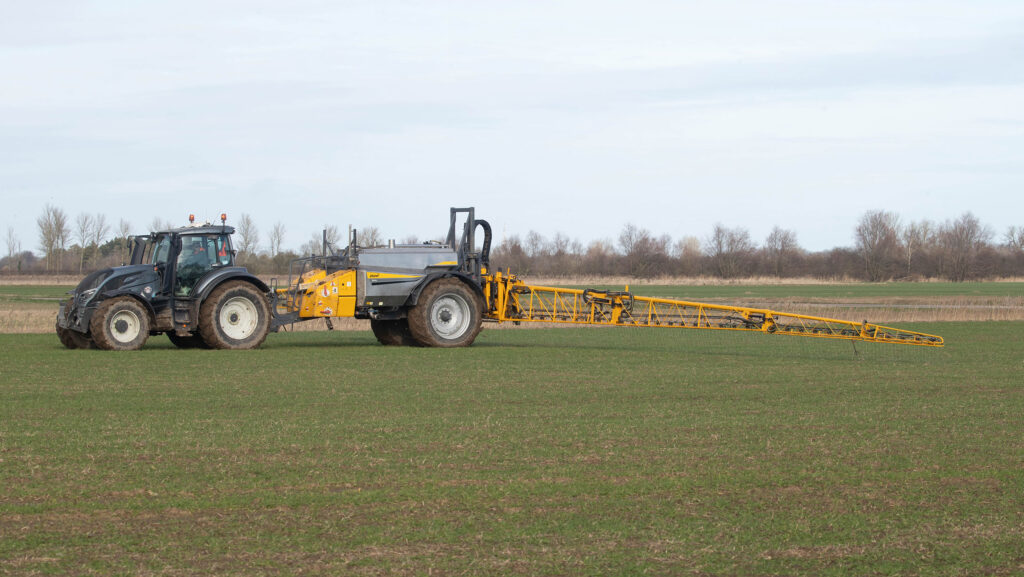Expert tips on managing very variable crops this spring
 © Tim Scrivener
© Tim Scrivener There is huge variation in winter cereals, ranging from lush winter barleys with 6-7 tillers to poor-rooted wheats that have just emerged after being mauled in mid-December.
While the UK situation is not as bad as last winter with more crops in the ground, there is once again a real mixed bag of growth stages and crop conditions to manage.
See also: Analysis: Is there still a place for pulses on UK arable farms?
This is largely due to an exceptionally wet September which disrupted fieldwork, especially in the South, with some areas seeing up to 350% of their average that month.
It resulted in a six week gap when drills were sat idle.
Two halves
Consequently, crops broadly fall into two categories – early and late, says ProCam head of crop production Mike Thornton.
For those who drilled early, it has paid off with well-established crops. However, the mild winter means disease, weed and virus pressure will be high and this will need managing.
For others, especially in the South, the wet pushed drilling well into November and these later crops will need a lot of help. They have been sat in wet conditions and their low rooting will increase lodging risk and lead to poorer nutrient uptake.
The resulting slow growth combined with heavy rainfall has had an impact on crop establishment and vigour.
Here, we take a closer look with three regional ProCam agronomists, offering pointers on how they plan to manage their crops using lessons from last season.
South
Based in Sussex, ProCam regional technical manager Justin Smith says that it’s so different to last season.
“Last year we escaped the worst that other areas experienced, but this year is looking much worse.”
He recalls that there were two drilling windows, early October and then mid-to-late November. Establishment has also been variable. “Later drilled winter wheat got hammered by slugs and birds.”
Where pre-emergence herbicides did get applied, they have worked reasonably well. But for those crops that haven’t had any will be under high weed pressure. These will need treating, but crops are stressed and susceptible to crop effect.
Therefore, Justin advises taking a field-by-field basis.
“If the weed burden is high and you need to apply herbicides before applying early plant nutrients, you should investigate whether you could include potential safeners, such as biostimulants and phosphites to help promote plant health and encourage early rooting.”
Then apply crop nutrition as soon as possible after these herbicide applications to further help mitigate the negative impacts of the herbicide application.
If the weed burden is low, he would look at applying plant nutrients first, allowing the plant to recover, and attack the weeds soon after.
However, this is with the caveat that farmers need to monitor weed growth very closely, as they can get caught out quickly by rising soil temperatures and day length which will enable weed growth to explode rapidly.
He also advises against any complicated tank mixes at this stage as this could further compound the problem of plant stress.
To promote rooting in backward crops, Justin will look to a range of tools including phosphite, plant growth regulators and biostimulants.
“Phosphite should be applied either prior to T0, or at the very latest, at the T0 timing.
“Products like Zodiac that include a mixture of seaweed and amino acids will help to promote root mass significantly.”
Another useful biostimulant is pidolic acid, which is applied a bit later – generally applied around the T0 timing. At growth stage 30, it will help promote primary and lateral roots.
Justin says the overall aim of both phosphite and the seaweed mix is to rapidly mobilise phosphites to encourage the plant to maintain tillers and encourage shoots.
Pidolic acid is also a signalling compound in nitrogen metabolism, increasing nitrogen assimilation, amino acid synthesis and protein production.
Finally, the growth promoter trinexapac-ethyl applied at T0 timing will help build cell wall strength and encourage rooting.
West and South Wales
In the West and Wales, cereal drilling got off to an early start as there is not the grassweed pressure like other areas of the UK, says Gareth Williams, a ProCam agronomist based in South Wales.
Winter barley went in from 15 September, but then the wet October halted drilling and it wasn’t until November that drills resumed with quite a bit of wheat mauled in.
Consequently, there is a huge range in crop stages. Gareth points to one client who started winter barley drilling on 15 September and was still drilling wheat in mid December, as there was a brief dry spell.
This spring, he will be taking a more field-by-field approach with the priority to stimulate rooting in backward crops by applying phosphite.
“We are in a mixed area so soils should normally have adequate nitrogen levels. However, there are indications this may not be the case in some fields.
“Forward winter wheat and barley has drained the bank of nitrogen to get the 6-7 tillers and will need nitrogen by mid February to avoid turning yellow and losing tillers.”
He will also use endophytes, which fix nitrogen from the atmosphere.
“The aim is to apply a slow release source of nitrogen on some crops. Slow release enables the crop to grow at a slower rate, therefore hopefully avoiding rapid stem elongation/lodging.”
Gareth adds that endophytes are not reliant on root systems for take-up through the soil – this matters when some crops are poorly rooted.
Disease pressure is also a concern in forward crops, especially as a lot of Graham is still being grown and its septoria rating is not what it used to be.
“There is some septoria already being seen due to the mild and wet conditions.”
Gareth will be looking to get a T0 fungicide on, with a multisite (such as folpet) to keep leaves clean, as got caught out the last two years in his area. Missing the T0 consequently put pressure on the T1.
North Lancashire and Cumbria
In Lancashire and Cumbria, ProCam agronomist Daniel Cottam says it has been a more normal start to the cropping season.
About 60-80% of the intended winter cereals have been drilled and this has largely depended on soil type.
Early-drilled crops are tillering and later drilled ones are still small.
One observation is that he is seeing isolated patches of puddling in fields that were completely under water last year despite being subsoiled.
He believes this suggests there is some compaction still to be tackled.
Being a mixed farming area, lots of manure went on, but he questions how much residual nitrogen remains in soils after the rain.
So he believes this spring is the ideal time to consider tissue testing to see what plants are getting from the soil ahead of applying fertiliser.
Soil testing may prove of limited value with poor rooting hampering uptake.
Forward crops will be especially hungry as more of the residual soil nitrogen was needed for the extra month in the ground.
So this needs to be factored in when deciding on early fertiliser.
With the late-drilled crops, many weren’t rolled and he doesn’t see rolling happening anytime soon, so won’t have the best root to soil contact.
Therefore, he will be looking to use both trinexapac-ethyl and chlormaquat growth regulators.
Chlormaquat will be applied at T0 to try and promote some tillering, improve rooting for anchorage and to promote uptake of water and nutrients.
This could be followed by a trinexapac-ethyl product applied at T1 to further thicken stems and stem walls, helping to reduce stem lodging and brackling in barley.
Especially where crops are already lush, this should reduce apical dominance and prevent crops from going leggy and, therefore, more prone to lodging.
However, the T0 chlormaquat may not be needed for those crops which are a bit further on and, therefore, less stressed, so just trinexapac at T1 may be suitable.
Whether more plant growth regulators will be required later in the season will have to be assessed at that time, he says.
Forward crops
- Early nitrogen to feed tillers
- Growth regulators to reduce lodging risk
- Disease risk higher, so T0 needed
Backward crops
- Early nitrogen to fuel biomass and rooting
- Weed control but care needed with stressed crops
- Promote rooting and tillering with phosphite, biostimulants and growth regulators
- Disease risk lower

